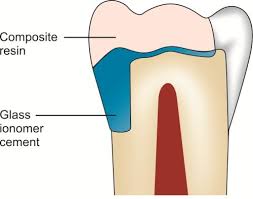
⦁ Sandwich technique for filling GIC- The sandwich of glass ionomer cement, dental adhesive and composite resin is an effective technique that optimally combines the desirable properties of the restorative materials.
⦁ In the sandwich technique, the GIC is placed as a liner or base, followed by placement of a resin composite to provide an aesthetic restoration of the remaining cavity
The Sandwich Technique for GIC filling may be open or closed.
- In the open technique, the GIC is used to replace the dentin and also fill the cervical part of the box, which results in a part of the GIC being exposed to the oral environment.
- Open technique is used when there is no remaining enamel at the gingival margin.
- In the closed technique, the dentin is covered by the GIC, which is in turn completely covered by the overlaying composite.
- Closed technique is used when there is remaining enamel at the gingival margin.
What is dycal exactly?
Dycal or Calcium Hydroxide Liner is a two-component, rigid-setting, self-curing material designed for use in direct and indirect pulp capping.
And as a protective liner under dental adhesives, varnishes, filling materials, cements, and other base materials.
Indications of dycal
i. Application to exposed, vital pulp tissue (direct pulp capping).
ii. Application to dentin as a protective barrier between restorative materials and deep vital dentin (indirect pulp capping) or where dentin to restorative material contact is not desired.
Contraindication of dycal
i. Increased calcium level in blood and urine.
ii. Kidney stone.
iii. Phosphate in blood.
iv. Increased level of vit D.
Advantages-
⦁ Promotes healing and repair
⦁ Stops internal resorption
⦁ Initially bactericidal then bacteriostatic
⦁ High PH stimulates fibroblast
⦁ Easy to use
Disadvantages-
⦁ Associated with primary tooth resorption
⦁ Does not exclusively stimulates dentinogenesis
⦁ Does exclusively stimulate reparative dentine
⦁ May degrade during acid etching.
Clinical process are as follows–
⦁ Moisten the prepared cavity. Using the cotton pliers, pick up a small cotton pellet, wet it and remove the excess water by squeezing it on the gauze.
⦁ Dispense the pastes. Dispense the base first.
⦁ Mix the Calcium Hydroxide.
⦁ Place the cement.
⦁ Allow the cement to set.
Visit us at bestorthodontistbracespune.in to know more.
